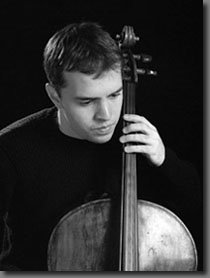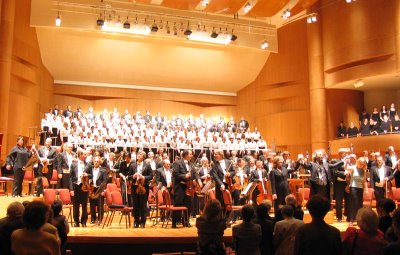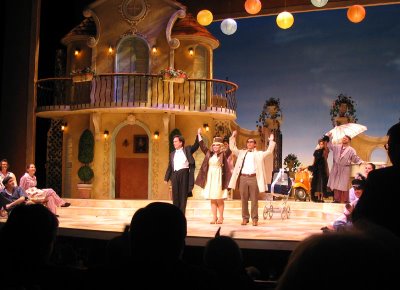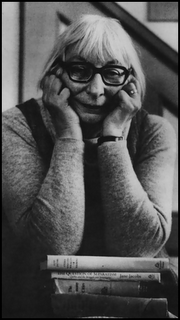Classical Month in Washington (May)
Classical Month in Washington is a monthly feature that appears on the first of the month. If there are concerts you would like to see included on our schedule, send your suggestions by e-mail (ionarts at gmail dot com). Happy listening!
Monday, May 1, 6 pm
Conservatory Project: Juilliard School of Music [FREE]
Cellist Avigail Arad, violinist Augustin Hadelich, and pianist Ang Li
Kennedy Center Terrace Theater
Monday, May 1, 8 pm
Ann Schein (piano), Jerome Barry (baritone), Peter Sirotin (violin), Claudia Chudacoff (violin), Michael Stepniak (viola), Thomas Kraines (cello)
Music by Schumann and Mozart
Embassy of the Federal Republic of Germany (Embassy Series)
See the review by Stephen Brookes (Washington Post, May 3)
Tuesday, May 2, 12:10 pm
Noontime Cantata: J. S. Bach, Höchsterwünschtes Freudenfest, BWV 194 [FREE]
Members of the Washington Bach Consort
Church of the Epiphany (13th and G Streets NW)
Tuesday, May 2, 6 pm
Conservatory Project: Eastman School of Music [FREE]
Violinist Bin Huang and pianist Xi Zhang (Vivaldi, Beethoven, Paganini, and Kreisler)
Kennedy Center Terrace Theater
Wednesday, May 3, 12:10 pm
Barbara Hollinshead, mezzo soprano, and Howard Bass, lute [FREE]
16th- and 17th-century music for voice and lute
Presented in honor of Master Drawings from the Woodner Collections
National Gallery of Art, West Building Lecture Hall
See the review by Joe Banno (Washington Post, May 5)
Wednesday, May 3, 6 pm
Conservatory Project: Peabody Conservatory of Music [FREE]
Duo Transatlantique—guitarists Maud Laforest and Benjamin Beirs, cellist Go Eun Park, and pianist Eun Jung Shon
Kennedy Center Terrace Theater
Wednesday, May 3, 7:30 pm
Ahn Trio [FREE]
Shenson Chamber Music Concert Series
National Museum of Women in the Arts
See the review by Charles T. Downey (Ionarts, May 4)
Thursday, May 4, 8 pm
Fine Arts Quartet
Shostakovich, Quartet No. 1; Bernard Herrmann, Echoes; Mozart, Viola Quintet with Daniel Foster
Clarice Smith Performing Arts Center
See the review by Gail Wein (Washington Post, May 6)
Friday, May 5, 6 pm
Conservatory Project: Shepherd School of Music at Rice University [FREE]
Kennedy Center Terrace Theater
Friday, May 5, 7:30 pm
Festa della Voce, Liederabend Concert
Music by Brahms, Wolf, Schumann, Schubert, Wolf, R. Strauss
Corcoran Gallery of Art
See the review by Jens F. Laurson (Ionarts, May 6)
Friday, May 5, 8 pm
Jacques Ogg, harpsichord [FREE]
Music by D'Anglebert, Muffat, Forqueray, Soler, C. P. E. Bach
Library of Congress
See the review by Charles T. Downey (Ionarts, May 6)
Friday, May 5, 8 pm
Baltimore Symphony: The Lure of the Diva
Emily Pulley (soprano), Lucille Beer (mezzo-soprano), Roger Honeywell (tenor), David Allen Miller (guest conductor)
Music Center at Strathmore
See the review by Mark J. Estren (Washington Post, May 8)
Saturday, May 6, pm
Conservatory Project: San Francisco Conservatory of Music [FREE]
Violinists Eunice Kim and Stella Chen, pianist Akimi Fukuhara (Sarasate, Ravel, Kreisler, and Liszt)
Kennedy Center Terrace Theater
Saturday, May 6, 7 pm; May 11, 14, 17, 19, 22, and 27
Mozart, La Clemenza di Tito
Washington National Opera
See the review by Jens F. Laurson (Ionarts, May 9)
Sunday, May 7, 3 pm
The Splendor of Bach: Cantata Fest (BWV 195, BWV 63, Brandenburg No. 1)
Washington Bach Consort
Rachel M. Schlesinger Concert Hall and Arts Center (Alexandria, Va.)
See the review by Andrew Lindemann Malone (Washington Post, May 9)
Sunday, May 7, 5 pm
Steve Silverman, piano/harpsichord [FREE, with price of admission]
Phillips Collection
Sunday, May 7, 6:30 pm
Steven Honigberg, cellist, and Kathryn Brake, pianist [FREE]
Music by Brahms, Chopin, Debussy, Mendelssohn, Astor Piazzolla, and David Popper
National Gallery of Art
Sunday, May 7, 7:30 pm
Martin Kasik, piano
Music by Chopin and Czech composers
The Mansion at Strathmore
Tuesday, May 9, 7:30 pm
Musicians from Marlboro III [FREE]
Mozart's Adagio and Fugue for String Quartet, K. 546; Schoenberg's op. 4 for String Quartet; and Schumann's Dichterliebe, op. 48
Freer Gallery of Art
See the review by Stephen Brookes (Washington Post, May 11)
Tuesday, May 9, 7:30 pm
Ian Bostridge and Dorothea Roeschmann, with Julius Drake
Vocal Arts Society
Kennedy Center Terrace Theater
See the review by Joe Banno (Washington Post, May 11)
Wednesday, May 10, 12:10 pm
Arco Voce [FREE]
17th- and 18-century music for voice and instruments
National Gallery of Art, East Building Small Auditorium
Wednesday, May 10, 7 pm
Karen Ouzounian (cello) and Víkingur Heiðar Ólafsson (piano)
Music by Beethoven, Debussy, Messiaen, Ligeti, Brahms
Residence of the Ambassador of Iceland
Thursday, May 11, 7 pm; Friday, May 12, 8 pm; Saturday, May 13, 8 pm
National Symphony Orchestra
Stravinsky, Symphonies of Wind Instruments (original 1920 version); Mendelssohn, Octet; Chávez, Toccata for Percussion Instruments; Bartók, Suite from The Miraculous Mandarin, Op. 19
Kennedy Center Concert Hall
See the review by Jens F. Laurson (Ionarts, May 12)
Thursday, May 11, 8 pm
Baltimore Symphony: The "Jazz" of Matisse
James Judd, conductor, and William Wolfram, piano
Bach/Stokowski’s Prelude and Fugue in C minor, Torke’s Bright Blue, Bernstein’s Symphony No. 2, "Age of Anxiety"
Music Center at Strathmore
See the review by Mark J. Estren (Washington Post, May 13)
Thursday, May 11, 8 pm
Vitaly Samoshko, piano
Music by Beethoven, Debussy, Rachmaninov, Prokofiev
Embassy of the Republic of Poland (Embassy Series)
See the review by George A. Pieler (Ionarts, May 12)
Friday, May 12, 12 noon
Opera Scenes (Part I) [FREE]
University of Maryland Opera Studio
Arts Club of Washington (2017 I Street NW)
Friday, May 12, 8 pm
Daedalus Quartet
Mendelssohn, String Quartet in D Major, Op. 44, No. 1; Bartók, String Quartet No. 3 (1928); Mozart, String Quintet in E-flat Major, K. 614 (with Roger Tapping on viola)
Corcoran Gallery of Art
See the review by Jens F. Laurson (Ionarts, May 15)
Friday, May 12, 8 pm (pre-concert presentation by Stephen Soderberg, 6:15 pm)
Morton Subotnick, Until Spring Revisited (solo laptop work in surround sound) [FREE]
Library of Congress
Friday, May 12, 8 pm
China National Symphony Orchestra
Music by Chinese and Russian composers
Music Center at Strathmore
See the review by Tim Page (Washington Post, May 15)
Friday, May 12, 7:30 pm
Villa-Lobos Trio
Embassy of Austria
See the review by Cecelia Porter (Washington Post, May 15)
Saturday, May 13, 4 pm
Motets in Honor of the Virgin Mary (Palestrina, Britten, Pärt, Rachmaninov, Aichinger)
Members of the Choir of the Basilica of the National Shrine of the Immaculate Conception
Sponsored by the Ecumenical Society of the Blessed Virgin Mary
Basilica of the National Shrine of the Immaculate Conception, Crypt Church
Saturday, May 13, 7 pm; May 15, 18, 21, 24, 26, 30, and June 3
Rossini, L'Italiana in Algeri
With Olga Borodina, Juan Diego Flórez, and Lyubov Petrova
Washington National Opera
See the review by Jens F. Laurson (Ionarts, May 16)
Saturday, May 13, 8 pm
Woodley Ensemble, Sacred Kaleidoscope
Sacred music from Canada, Indonesia, New Zealand, Sweden
St. Peter's Catholic Church (2nd and C Streets SE)
See the review by Joan Reinthaler (Washington Post, May 15)
Saturday, May 13, 8 pm
National Philharmonic: Mozart's Don Giovanni
Dean Elzinga, Vladimir Shvets, Jane Ohmes, John Aler
Music Center at Strathmore
See the review by Grace Jean (Washington Post, May 15)
Saturday, May 13, 8 pm
Prince George's Philharmonic
Music by Brahms and Elgar
Clarice Smith Performing Arts Center (College Park, Md.)
See the review by Andrew Lindemann Malone (Washington Post, May 15)
Saturday, May 13, 8 pm
Fairfax Symphony Orchestra, with Newman/Adkins/Mermagen Trio
Beethoven's Triple Concerto and Rachmaninov's second symphony
George Mason University Center for the Arts
See the review by Mark Estren (Washington Post, May 15)
Sunday, May 14, 5 pm
Christopher Guzman, piano [FREE, with price of admission]
Phillips Collection
See the review by George Pieler (Ionarts, May 16)
Sunday, May 14, 6:30 pm
Joseph Schwartz, pianist [FREE]
Music by Chopin, Debussy, and Schubert
National Gallery of Art
Sunday, May 14, 7:30 pm
Angela Hewitt, piano
Music by Rameau, Bach, Brahms
The Mity Clarke Gann Memorial Concert
Shriver Hall, Johns Hopkins (Baltimore, Md.)
See the review by Jens F. Laurson and Charles T. Downey (Ionarts, May 17)
Wednesday, May 17, 12:10 pm
Stephen Ackert, harpsichord [FREE]
Music by Gabrieli, Scarlatti, and anonymous 16th-century Italian composers
National Gallery of Art, West Building Lecture Hall
See the review by George Pieler (Ionarts, May 19)
Wednesday, May 17, 8 pm
Maurizio Pollini, piano
The Music Center at Strathmore (WPAS)
See the review by Jens F. Laurson (Ionarts, May 19)
Wednesday, May 17, 8 pm
Haydn Trio Eisenstadt
Embassy of Austria
See the review by Stephen Brookes (Washington Post, May 19)
Thursday, May 18, 8pm
Baltimore Symphony Orchestra, with conductor Roberto Minczuk and cellist Ilya Finkelshteyn
Music by Barber, Haydn, and Beethoven
Meyerhoff Symphony Hall (Baltimore, Md.)
See the review by Daniel Ginsberg (Washington Post, May 20)
Friday, May 19, 12 noon
Opera Scenes (Part II) [FREE]
University of Maryland Opera Studio
Arts Club of Washington (2017 I Street NW)
Friday, May 19, 7:30 pm
John Paul, harpsichord
Music from 18th-century France
The Mansion at Strathmore
Friday, May 19, 8 pm (pre-concert presentation by Susan Clermont, 6:15 pm)
Cho-Liang Lin (violin) and André-Michel Schub (piano) [FREE]
Mozart sonatas, Walton's Sonata for Violin and Piano (1950), and world premiere of a sonata by Bright Sheng
Library of Congress
See the review by George A. Pieler (Ionarts, May 20)
Friday, May 19, 8 pm; Saturday, May 20, 8 pm
Sarah Wolfson (soprano), Alexander Kaimbacher (tenor), Jerome Barry (baritone), George Peachey (piano)
Austrian and American operetta
Embassy of Austria (Embassy Series)
Friday, May 19, 7:30 pm; Saturday, May 20, 8:15 pm
Palestrina Choir:
Cathedral of St. Matthew the Apostle (Friday)
St. Rita’s Catholic Church, Alexandria (Saturday)
See the review by Charles T. Downey (Ionarts, May 20)
Saturday, May 20, 2 pm
Wonny Song, piano (WPAS)
Kennedy Center Terrace Theater
See the review by Jens F. Laurson (Ionarts, May 22)
Saturday, May 20, 3 pm
On Stage with Washington National Opera: American Opera [FREE]
Members of Washington Opera's Domingo-Cafritz Young Artists Program
For more information, call (202) 448-3412
Renwick Gallery, Grand Salon
See the review by George A. Pieler (Ionarts, May 28)
Saturday, May 20, time unknown
WPAS Annual Gala and Auction
Lang Lang, piano
Program TBA
Ronald Reagan Building and International Trade Center
Saturday, May 20, 8 pm
The Red Priest’s Vespers: Known and Less Known Masterworks by Vivaldi
Chantry and American Bach Sinfonia
Bradley Hills Presbyterian Church (Bethesda, Md.)
See the review by Charles T. Downey (Ionarts, May 23)
Saturday, May 20, 8 pm
National Philharmonic: All Tchaikovsky
Carter Brey, cello
Music Center at Strathmore
See the review by Joe Banno (Washington Post, May 22)
Saturday, May 20, 8 pm; Sunday, May 21, 2 pm
Haydn's La Canterina and Donizetti's Le Convenienze Teatrali
Directed by David Toulson
Opera Theatre of Northern Virginia
Thomas Jefferson Community Theater (Alexandria, Va.)
Sunday, May 21, 4 pm
Benjamin Britten, War Requiem
Cathedral Choral Society, with Marina Shaguch (soprano), Robin Leggate (tenor), Marcus Brück (baritone)
Washington National Cathedral
See the review by George A. Pieler (Ionarts, May 24)
Sunday, May 21, 5 pm
Contemporary Music Forum [FREE, with price of admission]
Phillips Collection
See the review by Stephen Brookes (Washington Post, May 23)
Sunday, May 21, 5 pm
Choral Arts Society of Washington, 40th Anniversary Celebration
Kennedy Center Concert Hall
See the review by Tim Page (Washington Post, May 23)
Sunday, May 21, 6:30 pm
National Gallery Orchestra, with Vladimir Lande, guest conductor, and James Bryla, clarinetist [FREE]
Music by Debussy and other composers
National Gallery of Art
Monday, May 22, 7:30 pm
Benjamin Britten, Turn of the Screw (fully staged)
Anne Dreyer, Jeffrey Lentz, Lorin Maazel
Fortas Chamber Music Series and the Chateauville Foundation
Kennedy Center Terrace Theater
See the review by Jens F. Laurson (Ionarts, May 25)
Monday, May 22, 7:30 pm
François Lazarevitch and the Musicians of Saint-Julien
Program of French Baroque music
La Maison Française
See the review by Cecelia Porter (Washington Post, May 24)
See the review by George A. Pieler (Ionarts, May 25)
Monday, May 22, 8 pm
National Symphony Orchestra/JCC Chamber Music Series
Jewish Community Center of Greater Washington (Rockville, Md.)
Tuesday, May 23, 12:10 pm
Suspicious Cheese Lords [FREE]
Church of the Epiphany (1317 G Street NW)
See the review from A Cappella News (May 26)
Tuesday, May 23, 7:30 pm
Washington Musica Viva
Music of Bach, Fauré, and Bloch
Dennis and Phillip Ratner Museum (Bethesda, Md.)
See the review by George A. Pieler (Ionarts, May 27)
Wednesday, May 24, 12:10 pm
Piffaro [FREE]
16th- and 17th-century music for wind instruments
National Gallery of Art, West Building Lecture Hall
Wednesday, May 24, 7:30 pm
Renaud Déjardin (cello) and Márta Godény (piano)
La Maison Française
See the review by Charles T. Downey (Ionarts, May 26)
Thursday, May 25, 8 pm; Friday, May 26, 8 pm; Saturday, May 27, 11 am (Casual Concert, without Shostakovich)
Baltimore Symphony Orchestra: The Maestro and the Masterpiece
With violinist Julia Fischer and (supposedly) Yuri Temirkanov
Weber's Euryanthe Overture, Beethoven's Violin Concerto, and Shostakovich's Symphony No. 1
Meyerhoff Symphony Hall (Baltimore, Md.)
See the review by Jens F. Laurson (Ionarts, May 26)
Friday, May 26, 8 pm; Saturday, May 27, 8 pm
Solomiya Ivakhiv (violin) and Roman Rabinovich (piano)
Embassy of Ukraine (Embassy Series)
Saturday, May 27, 2 pm
Bartók String Quartet
Bartók, Quartet No. 5 (1934); Mozart, Quartet in G major, K. 387
Library of Congress
Saturday, May 27, 8 pm
Klavier Trio Amsterdam
Mendelssohn, Trio in D Minor, op. 49; Joan Berkhemer, Trio in one movement (2000); Dmitri Shostakovitch, Trio, op. 67
The Lyceum (Alexandria, Va.)
Sunday, May 28, 5 pm
Yuliya Gorenman, piano [FREE, with price of admission]
Phillips Collection
See the review by Joe Banno (Washington Post, May 30)
Tuesday, May 30, 7:30 pm
Klavier Trio Amsterdam
Mozart, Trio in B, KV 502; Mendelssohn, Trio in d minor, op. 49; Ravel, Trio in A
La Maison Française
Wednesday, May 31, 12:10 pm
Ars Lyrica [FREE]
Music for voice and instruments by Dietrich Buxtehude, Giulio Caccini, Jean-Joseph Cassanéa de Mondonville, and Monteverdi
National Gallery of Art, West Building Lecture Hall






































































